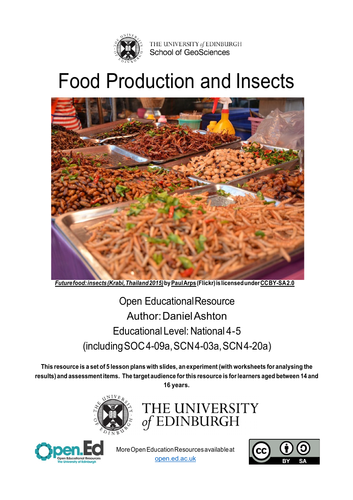


























This resource is a set of 5 lesson plans with slides, an experiment (with worksheets for analysing the results) and assessment items. The target audience for this resource is for learners aged between 14 and 16 years.
Entomophagy is the human consumption of insects as food - it represents a sustainable alternative to the environmentally destructive effects of livestock based protein. The lessons presented here are based around a project designed to test the food conversion efficiency and water footprint of mealworms.
The lessons are presented as 5 individual lessons each 50 minutes in length. They are designed to be incorporated into the school’s curriculum surrounding the food production unit for National 5 students. Providing that classes are taught when the food production unit would normally be delivered, these lessons can act as a detailed blueprint of how to teach the two related subjects in tandem.
This resource aims to cover the following Curriculum for Excellence benchmarks:
- SOC 4-09a - Having evaluated the role of agriculture in the production of food and raw material, I can draw reasoned conclusions about the environmental impacts and sustainability.
- SCN 4-03a - Through investigating the nitrogen cycle and evaluating results from practical experiments, I can suggest a design for a fertiliser, taking account of its environmental impact. (Particularly the points associated with “Explores and explains the possible impact of the use of fertilisers, for example, algal blooms.”)
- SCN 4-20a - I have researched new developments in science and can explain how their current or future applications might impact on modern life.
This resource was created as part of the GeoScience Outreach Course at the University of Edinburgh and was originally developed for the Trinity Academy in Edinburgh.
Author: Danny Ashton, adapted by Ana Mckellar.
Unless otherwise stated, all content is released under a CC-BY-SA 4.0 license.
Cover image is Future food: insects (Krabi, Thailand 2015) by Paul Arps (Flickr), licensed under CC BY-SA 2.0.
Something went wrong, please try again later.
This resource hasn't been reviewed yet
To ensure quality for our reviews, only customers who have downloaded this resource can review it
Report this resourceto let us know if it violates our terms and conditions.
Our customer service team will review your report and will be in touch.